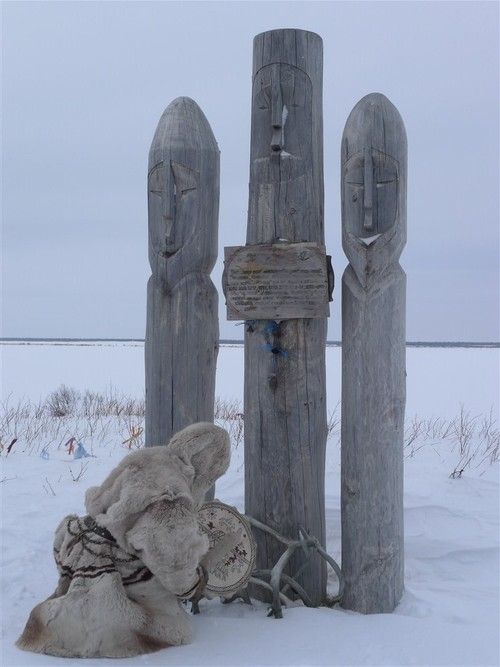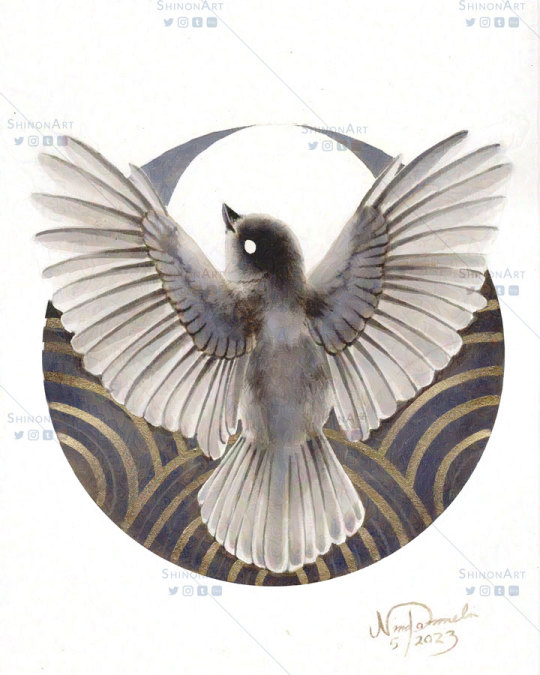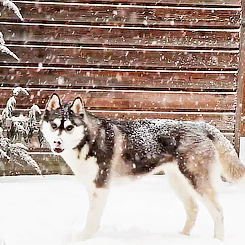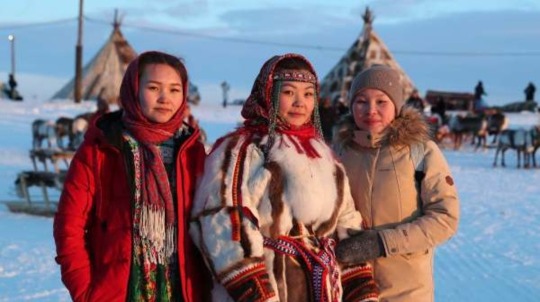#Siberian spirituality
Text

Pustozerk, Narayan mar, Russia.
#russia#russian paganism#indigenous russia#indigenous siberia#siberia#siberians#Siberian spirituality#Siberia Russia#Pustozerk#Narayan#Narayan mar#ruins#altar#idol#idol worship
2K notes
·
View notes
Text
Interacting With Souls and Ghosts in Shamanism: Shaman as Psychopomp
The duties of a shaman involve existence in the borderline states. They also imply crossing the boundaries of the worlds and interacting with the inhabitants of various layers of the universe: shaman both welcomes a new soul that has come into the human world, and accompanies the deceased to the Kingdom of the Dead.

View On WordPress
#anthropology#Buryat shamanism#ethnography#Mongolian shamanism#ongon#shaman drum#shamanic beliefs#shamanic journey#shamanic practices#shamanic rituals#shamanic visions#Siberian shamanism#spiritual practice#shamanism#shaman#shamanic practice#shamanic healing#folklore#folklore studies#nature worship#spiritualguidance#spiritual journey#spiritual practices#mysticism
4 notes
·
View notes
Text
youtube
Watch the American Climate Leadership Awards 2024 now: https://youtu.be/bWiW4Rp8vF0?feature=shared
The American Climate Leadership Awards 2024 broadcast recording is now available on ecoAmerica's YouTube channel for viewers to be inspired by active climate leaders. Watch to find out which finalist received the $50,000 grand prize! Hosted by Vanessa Hauc and featuring Bill McKibben and Katharine Hayhoe!
#ACLA24#ACLA24Leaders#youtube#youtube video#climate leaders#climate solutions#climate action#climate and environment#climate#climate change#climate and health#climate blog#climate justice#climate news#weather and climate#environmental news#environment#environmental awareness#environment and health#environmental#environmental issues#environmental justice#environment protection#environmental health#Youtube
3K notes
·
View notes
Text
Wait!
So you're telling me this whole Siberian orchestra is trans?!
0 notes
Text
I made this into its own post because i cant stop thinking about it the most underrated character in the movie: Iosef Vronsky

im still am convinced that it's wasn't the Maid or Katya by the end. it doesn't line up at all. It was Iosef.

as we see in the flashback Iosef was ex-KGB, he had the training and lets not forget the motive. he was betrayed in the worst way by the man he loved, he was exiled to the wilderness and lost everything.
yeah he was avowedly a pacifist but remember he was also a hunter, he survived the Siberian wilderness for 15 years! he was willing to make compromise for survival or as he put it: "to sustain the life from those who are already dead"
He doesn't view himself as a person anymore, he sees nothing but a worthless failure

observe how when he looks in the mirror to shave and the camera instead draws ur eye to the hunting trophy starting at the audience. a metaphor for how Isoef views himself
now what does that mean? We see later in the scene in the factory that he doesn't mean that literally but that those "whose souls have naught but stagnation creeping in them" no intellectual or emotional growth. which explains his hunting of animals, the odd death of O'Neil,

but most importantly the everything in the otherwise misplaced cathedral scene. a scene that is out of left field UNLESS IT WAS IOSEF.

So his philosophy of pacifism says the dead can be killed to help the living, dead means something with no chance of spiritual growth, he views himself as a dead waste of space.

notice that even tho they're at the funeral for O'Neil, Katya looks at Iosef with mourning as if he's the one in the casket. A hint at Iosef's lack of worth for his own life
in conclusion: Iosef set things up so ppl would want to kill him, hed get his revenge by proxy againt the Lieutenant, and his death would be t,he catalyst to ensure Goncharov wouldnt have to go thru the same suffering as he di!

did bc in the end Iosef still loved Goncharov. not as a lover or brother but as him seeing himself. seeing a hypothetical verison of him to not follow the same path Iosef did.
Which makes Goncharov's decision in the final act all the more tragic
2K notes
·
View notes
Text
Name-a-Thon: Water Tribe Resources
When doing research for this Tumblr, I come across a lot of interesting terms and mythological figures that immediately make me think, “That could be a name in Avatar!” so I thought I’d share some resources that could spark some inspiration when naming Avatar OCs.
My general advice would be to use words that are meaningful and relatively easy for an English speaker to pronounce. I also wouldn’t worry about the name being too literal or on-the-nose, most of the names in Avatar are puns that wouldn’t actually be names in real life, anyways.

Dictionaries
Canadian Inuit
Northern Labrador Inuttut
Labrador Inuktitut
Central Arctic Inuinnaqtun
Dialect Pronunciation Guides (Choose dialect then select glossary)
Alaskan Inupiat & Yupik
1970 Inupiat Dictionary
North Slope Inupiat
Northwestern Inupiat
Kobuk Junior Dictionary
King Island Inupiat
Alaskan Yupik Dictionary
Siberian Yupik Dictionary
Greenlandic (Kalaallisut)
2018 Dictionary
Glosbe Dictionary
Inuit Spirituality & Folk Tales
Project Gutenberg
World of Tales
The Canadian Encyclopedia
Wikipedia
Like what I’m doing? Tips always appreciated, never expected. ^_^
https://ko-fi.com/atlaculture
441 notes
·
View notes
Text

South-Eastern Poland, December, 1662 - three teenage girls of different faiths form a short-lived but memorable travel friendship
(from the left: a Tatar mercenary's sister, an Arian refugee and the daughter of a travelling Karaite Hakham. history notes under the cut)
the Arians, or Socinians, or as they called themselves, the Polish Brethren, were a radical branch of protestantism that constituted one of many religious minorities of the Polish-Lithuanian Commonwealth. their doctrine rejected many foundational Calvinist doctrines (such as predestination, divine nature of Christ, the trinity, etc) and preached principles of pacifism, separation of church and state, and equality between the genders. during the 1660s, when Poland-Lithuania was under attack by protestant Sweden, Arian men were banished from the country under threat of death - in 1662, the law was expanded to include Arian women, too. the Polish Brethren would not survive as a religious movement after exile.
Karaites are an ethnic and religious group of (most likely) Semitic origin, which have formed communities in Eastern Europe as far back as the 10th century. the Karaite faith split from Rabbinic Judaism probably around the 1st century bc. Karaims don't recognise Oral Law as legitimately binding and spiritual leaders/scholars, called Hakhams, have more of an advisory than authoritative role. Karaite communities in the Commonwealth suffered exceptionally heavy losses in the 1650s as a result of armed conflicts. today there are around 340 Karaites living in Poland and 200 or so in Lithuania, where the Karaim language is now used for liturgy, as opposed to the traditional Hebrew. despite the Karaite people Semitic origin, the Karaim language emerged in Crimea, from the Turkic language family, being derived from the now-extinct Kipchak - Karaim shares this origin with Tatar, Siberian Tatar and Crimean Tatar.
Tatar is an umbrella term for many different ethnic groups originating from 12th century Mongolia. Tatar settlers, polytheistic as well as Muslim, first came to Lithuania in the 14th century. as they started to be an integrated ethnic & religious minority of the Commonwealth, they came to be known as Lipka Tatars. their contribution to Polish-Lithuanian history mostly has to do with warfare, in which the conflicts of the 1600s are an important episode. today, there are 10-15 thousand Lipka Tatars in Poland, Lithuania and Belarus. (speak Polish? check this out!)
#oh clothes are inaccurate? try finding references for 17th century female clothing of a rural eastern european ethnic minority. try it.#ask box Open. goodnight.#eelart#history#17th century#PL
79 notes
·
View notes
Text

Blessing of the Siberian Jay
Fly, fly poor bird,
fly here to these lands.
To small trees,
low lands,
reach for the branches,
spread out on the sprigs!
Wait there, my birdie,
wait at the feet of the branch.
While the Siberian Jay was mostly a bird of good fortune and spirituality to some its appearance meant misfortune. It was believed that the Siberian Jay could hold a lot of things, such as human souls. Typically it was believed that the souls that passed on into a Siberian jay were hunters, witches, people who had gotten lost and died in the forest. Sometimes the deceased were given a wooden jay figurine as a memento.
Find me and my art elsewhere!
OLD GODS - Artworks inspired by Finnish mythology and Folklore
#siberianjay#jay#bird#birds#bird art#bird painting#folklore#finnish mythology#mythology#traditional art#traditional painting#artists on tumblr#old gods
130 notes
·
View notes
Text
Yall so uh I'm coming out as a therian😀(THIS IS ONE OF THE WORSE WAY TO TELL Y'ALL IM A THERIAN💀😭)


★Some things about me★
•if you guys want know my theriotype. It is a Siberian husky
•Is pretty rare for me for a Mental shift to happpen but as a kid A mental shift happen alot
•"What a therian?" A therian is someone who identifies as a specific non-human animal. Spiritually, psychologically, and emotionally, they relate to the essence and behaviors of this animal, even though they don’t have the physiology to match.
•Do I have any therian friends? Yes I have 4 of them
•Am I still going post Pj mask content??? YES OFC BECAUSE AS AWAY I NEVER LEAVE THE FANDOM😍
•Do I have a therian gear? Sadly no but remember that you don't need a gear to be a therian♥︎
•How long did it take me to find my theriotype? A YEARS!!😭🙏
•Did I have any memory of any past life? No I never have any memory of my past life but here a reminder that not all therian have past life
•Does Therian use letterbox?? THERIAN DON'T USE LETTERBOX Y'ALL!!!😭💀🙏🙏
•Are All therian zoophila and a peophilla? NO ALL THE PEOPLE IN THE THERIAN COMMUNITY ARE ACTUALLY ANTI ZOO AND ANTI PEO WHY WOULD YOU THINK THAT😨
•Have you ever have Been bully for being a therian? YEP ALOT OF TIME IN REAL LIFE AND ONLINE!!!!😔
★That all about me Bye★
29 notes
·
View notes
Text
My bone to pick with shitty hetalia "Siberia" OCs
Spoiler alert, they're all terrible!
Many people who make Siberia ocs often refer to Siberia as a nation. Siberia is not a nation, it is a large geographical area which is the home to many different ethnic groups.
This excuse is often made for singular "native American" ocs too; Using the excuse that because of the Russian conquest of Siberia which resulted in the massacre and displacement of the different peoples of Siberia, this is a justification to put all of these different groups into one, singular, Siberia OC, as apparently, there's no point in doing actual research into the different ethnic groups who are native to Siberia!
This I find to be blatantly disrespectful, conflating such diverse groups into one (often whitewashed as I'll get onto later) singular OC and flippantly saying "oh well a lot of them are dead now so..." is again, disrespectful and insensitive. A Tuvan is not an Evenk is not a Yakut is not a Buryat is not a Chukchi is not a Koryak.
That list I just gave you is just a small example of the sheer diversity of the ethnic groups who are native to Siberia.
It leaves a very bad taste in my mouth when people use the Russian conquest of Siberia - an already sensitive topic because of the displacements and killings of the native people of Siberia which in turn, resulted in an ethnic cleansing, as a vehicle to then create (as I said before, often whitewashed) OCs which dismiss the unique cultures and histories of these different groups. Do people...Not see the irony in this?
Honestly, just 5 minutes of research into the native groups of Siberia would show you that trying to conflate all of these different cultures into one just does not make sense regardless. Though these cultures share similarities because of course they are North East Asian - this is not a justification to waive off the diversity of these ethnic groups!
Let's take Buryats and Yakuts for example, two ethnic groups who live in Siberia and who are considered to be Siberians. Buryats are a Mongolic people, their culture is quite similar to that of Khalkha Mongols, the majority ethnic group in Mongolia. Yakuts on the other hand, are not a Mongolic group.
The Buryats live primarily in the Republic of Buryatia, located in southern Siberia, Russia, while the Yakuts, also known as the Sakha, inhabit the Sakha Republic (Yakutia) in the Russian Far East. Both groups have historically practised nomadic herding, but the Buryats traditionally focused on cattle herding and moved with their herds across the vast steppe, while the Yakuts were known for their reindeer herding and horse breeding in the Arctic and subarctic regions. The Buryats' culture has been heavily influenced by Tibetan Buddhism due to historical connections with Tibet, and shamanism also plays a significant role in their spiritual practices. The Yakuts' culture, in contrast, reflects influences from both Turkic and Siberian indigenous elements, with some Russian cultural assimilation over time.
Geographically speaking, they also differ. Buryatia is characterised by diverse landscapes, including mountains and lakes, while Yakutia is known for its extreme cold temperatures and vast tundra. Despite their differences, both groups have rich cultural heritages and face challenges in preserving their traditions and languages amidst Russian colonisation.
Just between Buryats and Yakuts, you can already see how they differ culturally and linguistically. Of course there will be some similarities as they are both Northern Asian cultures, but we don't give Spain and Portugal a singular personification because of similar characteristics/cultures now, do we?
Another issue I have with Siberia OCs is when, not only (by default) is a Siberia OC blatantly dismissive of the diversity of the ethnic groups who are native to Siberia, but when they make their already insensitive OC... White Russian, or half Russian? Do I even need to explain why this is offensive?
Yes, a majority of people who live in Siberia now are ethnic Russias. Do you ever... wonder why that is though?
What's worse is when people know, but then use the displacement of the people of Siberia as a justification to make their Siberia OC half Russian or white. This is blatant white washing, and though many groups are Russified, this does not mean that they've completely let go of their native culture and or are extinct, nor is it an excuse to ignore their native cultures to make an insensitive oc.
There is a difference in recognising that yes, some of these groups have gone through a process of Russification/have adopted many aspects Russian culture (to varying degrees depending on the group) , and straight up white washing their cultures by making a half white-Russian or a white Siberia OC - as if each of their unique identities do not deserve the agency to be represented by an equally unique and accurate personification.
Groups in Siberia never had strong relations with ethnic Russians until the Russian conquest of Siberia. It's okay to have an oc of a Siberian ethnic group which reflects the degree of Russification that that group underwent because (unfortunately) it's true for many of them - Kazakhstan for example is a central Asian country that underwent a process of Russification and it's accurate to reflect the degree to which Kazakhstan was Russified and how this affected him in his personification. Despite it being an unfortunate fact, you can't escape it, and I am not against reflecting this.
But it's a whole different ball game when you take already marginalised groups of people, squeeze their diverse cultures into a clusterfuck of an oc, which is already bad in and of itself… but then WHITEWASH THIS OC. EVEN WORSE WHEN THEIR CULTURES WERE ACTIVELY PERSECUTED BY THE RUSSIAN STATE, AND ARE STILL BEING PERSECUTED.
Further, the idea of making the Siberia OC "young" (even an oc of a singular Siberian ethnic group) as in, born during the Russian conquest era… and make Russia some sort of father to Siberia… This just absolutely reeks of paternalistic colonialist propaganda; the idea that these groups had no culture, no right to govern themselves or the idea that they didn't have the ability to govern themselves before the Russians came and subsequently "gave them culture" and "enlightened them" in their ways.
What other actual justification is there to do something like this? Seriously? When these cultures are actually quite old and predate the Russian conquest?
As a Filipino who has to deal with this sort of trash from Spaniards, it is not appreciated.
Further, if it wouldn't make sense to make a native American group OC half white because of white settlers in America, and if it wouldn't make sense to make the Philippines half Spanish because of our colonisation under the Spanish, why then is it ok to do it to the native people of Siberia?
This is the WORST part about Siberia ocs. But people who make their Siberia ocs the representation of 2p (or BOO! EVIL!) Russia.
This is so egregiously racist and I don't even know how people can headcanon this without even batting an eye.
First of all, making Siberia the "evil Asian" side of Russia… okay I've bloody banged on about this before but I really don't care at this point. This is stepping into peddling eugenicist racial science about Russian.
The rhetoric that Russians (but this also applies to other eastern Europeans, however I'm specifically talking about Russia here seeing as it's about Siberia ocs) are not "true Europeans" because of Asiatic influence, both from the past (Mongol invasions) and present (Russian Asians who are the result of the Russian conquest of Siberia and central Asia). And because of this, this means that Russians are also a load of evil, Eastern Hordes too because of their so called "Asiatic" heritage.
There's a saying in some Eastern European countries about Russians. It goes something along the lines of "Scratch a Russian, you'll find a Tatar." This is used in an offensive manner to basically call Russians subhuman or evil because of their so-called "tatar" (Asian) heritage.
Keeping this in mind… Making Siberia… the "evil Asian side" of Russia… yeah I'm not beating around the bush with this one. You're a filthy racist if you do this.
It's even more egregious when you're using Siberians as a justification to make your cheap 2p Russia OC evil, as if SIBERIANS are the aggressors towards Russians. WHEN THEY WERE THE ONES WHO ARE COLONISED BY RUSSIA AND TO THIS DAY FACE MARGINALISATION UNDER THE RUSSIAN STATE. BUT NO. THEY'RE THE BIG EVIL AGGRESSORS TOWARDS YOUR INNOCENT WHITE BLORBO, RIGHT?
tl;dr If you have a singular "Siberia" oc it's trash no matter what, hope this helps 👍
#hetalia#hetalia world stars#hetalia world series#hetalia world twinkle#hetalia discourse#Hetalia racism#Hetalia Russia#Aph Russia#Hws Russia#ivan braginsky#Aph Siberia#Hws Siberia#Hetalia Siberia#Siberia oc#2p Russia#2p!Russia#2p hetalia#2p!hetalia#Not aimed at any of my followers btw ik there are some people who used to have Siberia ocs but realised it was offensive#Dw it's aimed at people who continue to do this despite knowing otherwise
73 notes
·
View notes
Text
Russia, Explained: Siberian Indigenous Population Halves Amid Suicide Epidemic
By Aliide Naylor
April 8, 2021
A suicide epidemic is ravaging indigenous nations in Siberia.

A suicide epidemic is ravaging indigenous nations in Siberia. The Uralic Nganasan community in Siberia’s northern reaches is disappearing at a shocking rate – just three decades ago, there were some 1,300. Now, there are only around 700.
In the Nganasan settlement of Ust-Avam in Krasnoyarsk Krai, there are more suicides than natural deaths. “Six people die here every year. One of these deaths is the result of natural causes. Two or three freeze or die drunk. And two or three kill themselves,” writeNovaya Gazeta special correspondents Elena Kostyuchenko and Yuri Kozyrev after visiting the region.
The community is suffering the devastating effects of global warming, man-made environmental degradation, and severe poverty fuel depression. Out of 359 residents, just 54 have jobs.
“People crack, young people in general break down. The suicide rate is higher among young people. There is no work, nothing. Here you need to pay for lighting, and need to work for food. There is no food, no work, no money,” one young resident says. Her sister also committed suicide, leaving behind an 11-year-old son.
It’s often necessary to rely on anecdotal evidence about indigenous issues. Media reports are sparse and obtaining concrete statistical evidence about indigenous tribes such as the Nganasan is tough. And some deaths may be portrayed as suicides when there is little public information about the facts (for example, the death of one 15-year-old girl, in an uncomfortably termed “relationship” with a 24-year-old adult male police officer wasstyled in 2004 as a Romeo and Juliet story by local press).
The Nganasan are the descendants of semi-nomadic reindeer hunters, with ancient roots and a shamanistic spiritual culture. Even under Peter the Great (in the 17th and 18th centuries) there was a drive to “civilize” Russians in the further-flung regions and catch up with Europe, writes historian Yuri Slezkine. Peter instructed missionaries to find native Siberians and their “seductive false gods-idols and burn them with fire … and destroy their heathen temples”. Such ideas gained greater momentum in the 20th century, and the indigenous people were later forced into reservations under the Soviets in the 1930s. Nomadic civilizations were considered fundamentally incompatible with government-sanctioned lifestyles and these “small nations” of the North were seen as somehow representative of an undesirable past.
The Soviet state collectivized their personal property, including tents, guns and traps, and even reindeer herds. This led to a complete loss of reindeer husbandry and resulted in a steep decline in the reindeer population from the 1950s onwards.
Meanwhile, Soviet enforcement of Russian literacy made the local language almost extinct. Much like practices imposed on indigenous communities in other parts of the world, the Kremlin would take away local kids from their parents and send them to study in boarding schools.
“There, speaking Nganasan was forbidden, and teachers punished them for every Nganasan word they used — beaten with canes, kicked out of the class,” said local linguist Valentin Gusev. Today, Russia is home to 260,000 people from indigenous communities – who constitute just 0.2% of the country’s population. The government officially recognizes 40 separate indigenous groups in the North, Siberia, and the Far East.
The catastrophic impact of climate change in the Russian Arctic limits the Nganasan’s fishing opportunities — their primary food source. Meanwhile, the government continues to restrict hunting, which is a widespread source of tension between the Kremlin and indigenous communities elsewhere across Russia. With a de factoban on hunting, the Nganasans stopped following the routes of wild herds. Local food available for purchase can be out of date or moldy, and chronic alcohol use continues to plague the population.
Aggressive industrial development in the Russian Arctic has massively exacerbated the crisis among the Nganasan. Last year, a Norilsk Nickel (Nornickel) diesel spillbecame the largest human-made fuel spill in Arctic history, after which Russia’s government colludedwith the company (which is the nation’s largest nickel producer) to whitewash the disaster. The spill affected the environment that provided the Nganasan with basic food supplies. “They catch fish; they hunt deer. But there are no fish this year. And the deer left for other lands three years ago,” Kostyuchenko and Kozyrev wrote.
Last year, northern indigenous tribes signed an open letterto US business magnate Elon Musk and Tesla asking him not to purchase any nickel, copper, and other materials from Nornickel in the wake of the disaster. On average, the Norilsk Mining and Metallurgical Combine plant has released 30 tons of metallic dust and heavy metal oxides annually since it began production in the late 1930s, according toresearcher Konstantin B. Klokov.
There has been a recent spikemore generally in tensions between federal authorities and indigenous communities. Some of these nations have mobilized against an over-centralized state, government-backed environmental assaults on their sacred lands, and have demanded the return of their autonomy. In Kalmykia, for example, the majority-Buddhist region has engaged in protests against a Kremlin-appointed mayor. In Buryatia, locals rallied against a rigged election for weeks. And in a case that sent waves across Russia, a Sámi activist filed a complaint with Russia’s Supreme Court last year, after the government denied him the right to hunt without a license.
#indigenous#culture#indigenous russia#indigenous russian#russia#important#fypシ#colonization#fypage#landback#siberian indigenous#siberia#indigenous siberian#siberian#russian imperialism#russian genocide#russian colonization#land back#Nganasan#Uralic
99 notes
·
View notes
Text
The Many Lives of Mongolian Shamanism

The following is excerpted from Sky Shamans of Mongolia: Meetings with Remarkable Healers by Kevin Turner.
For thousands of years, Mongolia has been a nexus of Eurasian shamanisms that competed, mixed, and meshed across our planet's largest continent. Shamanism appears to have emerged with the very dawn of human consciousness, but archeologists can probably speak with confidence about only the past 30,000 to 70,000 years.
Archeological discoveries in Eurasia alone indicate that the practice of shamanism reaches back at least to 35,000 BCE, easily making shamanism the oldest spiritual practice known to mankind. Modern religious faiths such as Buddhism and Christianity are toddlers in comparison, and psychology is a mere newborn.
The word shaman originated from the Tungusic tribal language groups (from areas to the north and east of Mongolia), which are related to Mongolic languages. These are both part of the broader Altaic language group, which includes Turkic, Manchurian, and scores of other Inner Asian and Siberian languages, and may include Korean and Japanese at the easternmost reach. The modern term "shaman" has now been adopted by many as a catch-all word to describe those who by spiritual means seek direct access to information and healing power not ordinarily available.
The nomadic northern Siberian shamanic traditions tend to retain the highly individualistic aspects of shamanism; by contrast, a most interesting facet of Mongolian and Inner Asian shamanism is the amalgamation of the shamans' direct experiences of other realities with a religious belief system known as Tengerism (Heaven or Sky God-ism). Tengerism originated in Sumeria, one of humanity's earliest civilizations, and probably derived from the early experiences of the shamans, prophets, and mystics of pre-Mesopotamian eras.
The modern Mongolian term Tenger (or Tengri), meaning both "sky realms" and "sky spirits," almost certainly derives from the Sumerian word Dingir, also meaning both "sky realm(s)" and "deity(-ies)." The concept of divinity in Sumerian was closely associated with the heavens, evident from the shared cuneiform sign for both heaven and sky, and from the fact that its earliest form is a star shape. The name of every deity in Sumerian is prefixed by a star symbol.
Mircea Eliade proposed that Tengrism may be the closest thing we have found to a reconstructed proto-Indo-European religion. It is also evident that Tengrism's three-layered worldview is nearly identical to the tripartite world found in many kinds of shamanism, as well as the Vedic triloka ("three realms") world structure.
In Mongolian, one who travels the realms of the Tengers is called a Tengeri--"sky-dweller; sky-walker." I like to think that Luke Skywalker, the young warrior-shaman Jedi knight of the fictional Star Wars films, may have inherited his name from this tradition. Interestingly, the BBC reports that in censuses taken in 2001 regarding spiritual beliefs, hundreds of thousands of people selected "Jediism" as their faith of choice--such is the power of shamanism even in our modern myths and legends.
The earliest authenticated records of Mongolian shamanism go back to the beginnings of the Hunnu Dynasty, 209-93 CE (also known as the Xiongnu in Chinese records). Mongolian legend tells us that, during this time, a nine-year-old Hunnu boy united with a she-wolf, engendering the modern-day Mongolian people. The headdress of a shaman (circa 300–100 BCE) was found in one of the graves of Noin-Ula (Mongolian: Noyon uulyn bulsh) in northern Mongolia, and is strikingly similar to the Mongol Darkhad headdress of today. The fabric's colors, weaving methods, and embroidery are also similar to those found in fabric produced by Scythians in the Greek colonies on the Black Sea coast, leading scholars to draw links between these ancient cultures. (Scythian tribal areas were just west of Mongolian territories.)
According to historian and researcher Otgony Purev, shamans played an important role in diplomatic efforts and treaties with neighboring nations. The Hunnu emperors even constructed permanent shamanic shrines, and encouraged individual shamans to synthesize their diverse practices into a national religion. "Shamanist religion" then became part of the organizational basis of governmental and military activity.
Shamanism became the main source of education and ideology for the earliest pre-Mongol states. This continued for nearly 400 years, and ties to education remain influential in the Mongolian shamanic revival even today. With the disintegration of the Hunnu Dynasty, institutionalized shamanism returned to its more natural, individualistic and autonomous forms across a series of disparate Inner Asian kingdoms that spanned a millennium.
23 notes
·
View notes
Note
are the lil flowers inside the glass turtles specific kinds of flowers and if so do they have a meaning relating to the respective turtle?? 🤔🤔
Yes, they are specific flowers :D
Leo's flowers are based on the Siberian Larkspur (I believe that's what you call it?), Mikey's flowers are Tiger Lilies, and Donnie's flowers are Lupines/Bluebonnets! When I post Raph's, it'll be pretty obvious what his flowers are :)
I didn't choose the flowers for any specific meaning (I was just looking for ones that fit their color schemes tbh), but a do like some of the symbolism! From what I can find, Siberian Larkspur represents intuition, inner wisdom, and spiritual prowess, which works wonderfully for any Leonardo; Tiger Lily represents compassion, confidence, and strength, which is perfect for Mikey; and Lupine represents voraciousness, loyalty to family, and admiration, which I think works well for Donnie! 🩵🧡💜
8 notes
·
View notes
Text


The planet Earth is the third planet in the Sol system, a vibrant terran world with a diverse biosphere recovering from a near-miss ecological collapse. It has six major landmasses surrounded by vast oceans of liquid water, and its atmosphere is a comfortable nitrogen-oxygen blend at a pressure that is dense enough to protect but not enough to crush. It also has one relatively large, airless, rocky moon, called Luna (or simply "the Moon.")
Earth is also home to an indigenous sophont species: humans, one of the founding members of the United Nations Aerospace Coalition. Because of its deep pre-spaceflight cultural history, it is one of a minority of worlds divided into nations, hence its primary governing body being the United Nations of Earth -the ancestor to most of humankind's modern administrative structure. Being Earth's only natural moon, Luna was the site of humans' first forays into extraterrestrial exploration, and today is an industrial powerhouse under the flag of the UN Autonomous Territory of Luna. The Earth-Moon Union (EMU, for short; top flag) is composed of the United Nations of Earth (bottom left flag) and the Autonomous Territory of Luna (bottom right flag), with its primary seat being Midway Station located at the L-1 gravitational stability keyhole between Earth and Luna.
As the birthplace of the human species, the Earth is the most populous and powerful asteropolitical entity in the Sol system, and quite possibly in the entire United Nations of Humanity. Earth itself has a population of just over 8 billion, which has stayed relatively stable since the 21st century. Together with the Moon’s 240 million inhabitants, the total population of the EMU is about 8.4 billion, almost four times that of the next largest entity in the system (Mars).
While Luna’s primary industry in the modern day is mining, Earth’s rich cultural and biological history makes it a tourist destination renowned across known space, though it has stringent biosecurity. For many, it is even a spiritual experience, some going so far as to make it their life’s goal to retire on Earth and connect with the home of their ancestors. Centuries of ecological engineering and conservation have managed to avert the effects of early human industry, restoring the world to a natural balance and even reviving many species driven extinct by human error. Today, one can watch herds of mammoth roam the Siberian tundra, visit dodo birds on Mauritius, or experience the return of Australia’s Great Barrier Reef. 30th century Earth is a good place to be, and humanity is collectively proud of their home: the cradle of the Diaspora.
hey look, more art! been a hot minute. photobash of a future Earth and its well-settled Moon, plus their flags, created for my hard science fiction setting Astra Planeta. done using assets from Space Engine.
#spyglass’ realms#astra planeta#spy arts#spy writes#worldbuilding#space#space art#future history#futurism#science fiction#hard science fiction#scifi#hard scifi#scifi art#scifi writing#photoshop#not actually done with photoshop tho lol fuck adobe
26 notes
·
View notes
Text

It is only by being a prisoner for religious convictions in a Soviet camp that one can really understand the mystery of the fall of the first man, the mystical meaning of the redemption of all creation, and the great victory of Christ over the forces of evil. It is only when we suffer for the ideals of the Holy Gospel that we can realize our sinful infirmity and our unworthiness in comparison with the great martyrs of the first Christian Church. Only then can we grasp the absolute necessity for profound meekness and humility, without which we cannot be saved; only then can we begin to discern the passing image of the seen, and the eternal life of the Unseen.
On Easter Day all of us who were imprisoned for religious convictions were united in the one joy of Christ. We were all taken into one feeling, into one spiritual triumph, glorifying the one eternal God. There was no solemn Paschal service with the ringing of church bells, no possibility in our camp to gather for worship, to dress up for the festival, to prepare Easter dishes. On the contrary, there was even more work and more interference than usual. All the prisoners here for religious convictions, whatever their denomination, were surrounded by more spying, by more threats from the secret police.
Yet Easter was there: great, holy, spiritual, unforgettable. It was blessed by the presence of our risen God among us -- blessed by the silent Siberian stars and by our sorrows. How our hearts beat joyfully in communion with the great Resurrection! Death is conquered, fear no more, an eternal Easter is given to us! Full of this marvellous Easter, we send you form our prison camp the victorious and joyful tidings: Christ is risen!
-- Letter from a Soviet concentration camp
9 notes
·
View notes
Note
Top 10 favorite albums (or whichever ones you've been enjoying the most)
it was only this year that it occurred to me to start keeping lists of our favourite things because our memory is like swiss fucking cheese (as previously discussed lol) so this is gonna be a bit haphazard and I'm definitely gonna wake up at 02:00 in a cold sweat like "FUCK I FORGOT [x]" but. 🎵 these are the breeeeaks! 🎵 anyway.
i. DARK SIDE OF THE MOON | pink floyd
hated PF as a kid listening to rock radio, their dreamy sound bored the fuck out of me, but now that I'm a stoner PF makes way more sense
that's not relevant to DSotM though, I just love this album because it's about madness and entropy and death and also has the best middle track and outro track ever invented
standout track: Eclipse
ii. BETWEEN THE HEART AND THE SYNAPSE | the receiving end of sirens
post-hardcore concept album with copious use of harmonies and haunting lyrics. this band was a flash in the pan that left scorch marks on my entire existence
standout track: Epilogue
iii. THIS GODLESS ENDEAVOR | nevermore
my introduction to Nevermore that still remains my favourite work by them. what a fucking band. Warrel Dane's vocals are insane. it's just good idk what to say
standout track: Sentient 6
iv. MABOOL: THE STORY OF THE THREE SONS OF SEVEN | orphaned land
here we start getting into albums I don't listen to from beginning to end often bc there are individual songs that I don't really care for BUT it's such a cohesive and beautiful story when you do listen to it from beginning to end that I still do it sometimes anyway. this is a concept album about Noah and the Ark by an Israeli metal band. like. come on. what more do you WANT from LIFE
standout track: The Storm Still Rages Inside
v. REQUIEM FOR A DREAM OST | Clint Mansell + Kronos Quartet
I am rabid for both Mansell and the Kronos Quartet. I would die for them. honourable mention to The Fountain OST here which not only is my favourite movie but it has the one song in existence that makes me say "if I were a song I would be this song"
standout track: listen idk it's just two leitmotifs the entire time, a lot of them are the same tune with different spices added
vi. STRANGER FRUIT | zeal & ardor
who are my favourite band so it's kinda funny it took me this long to bring them up but YKNOW
"satanic negro spirituals and btw, make it metal" is a genre that is 100% tailored to me personally (their later albums are less Specific vibes-wise which is a shame but yknow what... the shit still slaps so I'm not too mad)
standout track: You Ain't Coming Back
vii. BEETHOVEN'S LAST NIGHT | trans-siberian orchestra
they don't just make metal Christmas music!
standout track: Mephistopheles' Return
viii. GARDEN WINDOW | o'brother
vibes. pure vibes. idek how else to explain this band but. whew
standout track: Poison!
ix. THE DOOMSTAR REQUIEM | dethklok (metalocalypse)
Metalocalypse's rock opera has some of the catchiest metal songs I've ever heard. also. it's a rock opera. likeeee come ONNN *gesticulating madly*
standout track: *impales self on spikes instead of trying to choose*
x. NYMPHETAMINE | cradle of filth
you already know 🤘🏿
standout track: Absinthe With Faust
#watch tumblr break the fuck out of my formatting like usual#if it comes out lookin funny just wait five minutes i'll fix it#edit: ok fixed lol#MUSICCCCC *chews drywall*#audiophilia
7 notes
·
View notes
Note
loved the omnics reactions to "Genesis" documentary. But what about the characters that have a close relationship with omnics? such as Tracer, Genji, Torb or Zarya? (also Bastion)
Well Bastion would just be *thoughtful, reverent beeps followed by several questioning chirrups about the nature and implications of sentience for omnics with significantly reduced faculties for expression*
Torbjörn: Never was a spiritual type. For me, I always figured we had to solve our own problems. None of us are born perfect, there's no grand meaning behind it, it's just a matter of figuring out how to make the lot you're given work for you. I still don't see how it would work for robots, exactly. The way Bastion stares at things though... it makes some kind of sense. Sort of. There's a lot I can't explain about Bastion already, so what's one more thing?
Tracer: Ever since I went to that funeral for Lady it's always been something I've been scared to really ask about. I read some files on Liao's work during my time with Overwatch, but what it took to end the war... how finite it all is, and how they're all a part of this whole in the face of that.
Genji: It's a very well-done documentary, it just... probably doesn't hit the same if you've already spent monks about the Shambali. It's odd being able to differentiate between what is packaged for a wider audience and what is practice as a community.
Zarya: So... Did the Siberian Omnium get the message?
11 notes
·
View notes